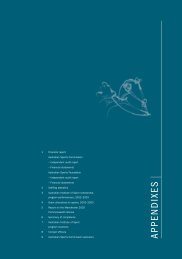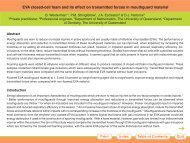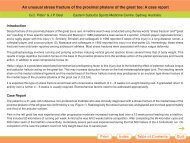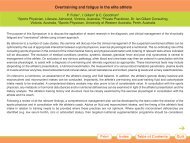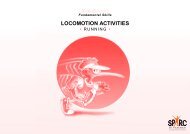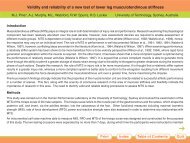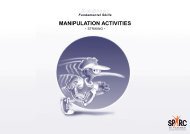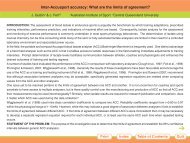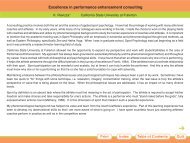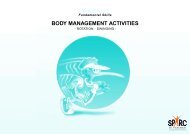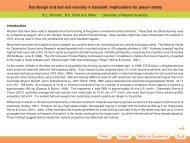MANIPULATION ACTIVITIES
MANIPULATION ACTIVITIES
MANIPULATION ACTIVITIES
You also want an ePaper? Increase the reach of your titles
YUMPU automatically turns print PDFs into web optimized ePapers that Google loves.
K IWIS PORT<br />
Fundamental Skills<br />
<strong>MANIPULATION</strong> <strong>ACTIVITIES</strong><br />
• PASSING & THROWING •
Manipulation activities passing and throwing<br />
KiwiSport Fundamental Skills<br />
PASSING AND THROWING<br />
The aim of KiwiSport Fundamental Skills is to develop basic sports skills through simple,<br />
enjoyable play activities.<br />
This section contains those which are pertinent to passing and throwing They are grouped<br />
for:<br />
• Exploring passing and throwing.<br />
• Passing a large ball from the spot.<br />
• Passing and moving with a large ball.<br />
• Passing a large ball with opposition.<br />
• Throwing small balls.<br />
• Underarm throw.<br />
• Overarm throw.<br />
• Overarm bowling.<br />
Activities are generally arranged from the simplest to the most complex.<br />
The activities have been selected with schools specifically in mind but an input of professional<br />
skill and judgement is needed to ensure lively and relevant programmes. Decisions will<br />
need to be made on when and how the activities are used and what modifications are needed<br />
to match age and ability.<br />
The activities also fill a need outside class programmes. They are useful for children’s learning<br />
and play at any time – lunch time, after school, sports training, holiday programmes and at<br />
home.<br />
Parents and others who play with children in informal situations should find the ideas<br />
particularly helpful.<br />
2
Manipulation activities passing and throwing<br />
EXPLORING PASSING/THROWING<br />
ACTIVITY 175 EXPERIMENTING WITH THROWING<br />
BEFORE THE ACTIVITY<br />
A wide variety of articles safe to throw – all types of balls, bean bags, quoits,<br />
frisbees, plastic containers, light blocks.<br />
DURING THE ACTIVITY<br />
• Group spread out with an article each. Who can throw ...?<br />
– in the air with two hands/one hand.<br />
– as high as your head.<br />
– above your head.<br />
– very high.<br />
– a different article.<br />
• Spread along a line. Can you throw ...?<br />
– a long way.<br />
– along the ground.<br />
– high and long.<br />
– at a target.<br />
– a different article then run and retrieve.<br />
– in different ways.<br />
• With a partner:<br />
– Who can throw to make it easy to catch?<br />
– How many ways can you throw?<br />
– What is easiest to throw?<br />
– What throw is best when you are close together/a long way apart?<br />
LOOK FOR<br />
• finger grips.<br />
• long arm action.<br />
• stepping in direction of throw.<br />
KiwiSport Fundamental Skills<br />
PASSING A LARGE BALL FROM THE SPOT<br />
ACTIVITY 176 EXPLORING LARGE BALL PASSING<br />
BEFORE THE ACTIVITY<br />
Large balls.<br />
Grass or hard area.<br />
Markers.<br />
DURING THE ACTIVITY<br />
• Pairs with a ball freely spaced or in lines facing each other.<br />
Guide exploration by asking ‘Can you pass. . .’? or ‘Who can pass. . .’?<br />
– with two hands.<br />
– with one hand.<br />
– with the other hand.<br />
– up high.<br />
– down low.<br />
– bouncing off the ground.<br />
– at chest level.<br />
– sitting down.<br />
– kneeling.<br />
– from the shoulder.<br />
– changing the distance.<br />
LOOK FOR<br />
• fingers spread behind the ball.<br />
• step into the pass.<br />
• follow through.<br />
3
Manipulation activities passing and throwing<br />
PASSING A LARGE BALL FROM THE SPOT<br />
ACTIVITY 177 CIRCLE PASSING<br />
BEFORE THE ACTIVITY<br />
Large balls.<br />
Grass or hard area.<br />
DURING THE ACTIVITY<br />
• In circles of five or six, each circle with two balls.<br />
– Throw/pass a ball around the circle. Reverse direction on signal.<br />
– Throw/pass two balls – Can one catch the other?<br />
– Throw/pass to anyone – one ball then two balls.<br />
– Throw/pass to every second person.<br />
– How quickly can you make ten passes?<br />
– Face one way and pass back overhead.<br />
– Pass to anyone except an adjacent player. How many passes can you<br />
make in 30 seconds.<br />
• Leader in the centre of a circle.<br />
– Throw/pass to each in turn.<br />
– Throw/pass to anyone.<br />
– Throw/pass two balls. As one is passed out the other is passed in.<br />
LOOK FOR<br />
• fingers spread behind ball.<br />
• step in the direction of the pass/throw.<br />
• follow through.<br />
VARIATIONS<br />
• Designate the pass/throw.<br />
• Try different balls.<br />
• Increase or decrease distances.<br />
KiwiSport Fundamental Skills<br />
PASSING A LARGE BALL FROM THE SPOT<br />
ACTIVITY 178 ZIG ZAG PASSING<br />
BEFORE THE ACTIVITY<br />
Large balls.<br />
Grass or hard area.<br />
DURING THE ACTIVITY<br />
Groups of five or six in zig zag.<br />
Three balls each group.<br />
• Throw/pass a ball zig zag up and down.<br />
• Throw/pass up one side and down the other.<br />
• Throw/pass one ball, when it reaches the end pass the next – and the<br />
next.<br />
• Throw/pass one ball, then the next, then the next etc.<br />
• How many passes in . . . secs?<br />
• Using two balls, throw/pass to anyone on the other line without a ball.<br />
LOOK FOR<br />
• fingers spread behind ball.<br />
• step in direction of pass/throw.<br />
• follow through.<br />
VARIATIONS<br />
• Vary the distances.<br />
• Use different balls.<br />
4
Manipulation activities passing and throwing<br />
PASSING A LARGE BALL FROM THE SPOT<br />
ACTIVITY 179 DOG AND RABBIT<br />
BEFORE THE ACTIVITY<br />
Two large balls per group.<br />
Grass, hard surface.<br />
DURING THE ACTIVITY<br />
• A group of six/seven in a circle with a ball on opposite sides.<br />
One ball is the rabbit, the other the dog. The balls are passed around the<br />
circle to try and make the dog catch the rabbit. Reverse the direction of<br />
the chase by calling change, especially when the dog is about to catch the<br />
rabbit.<br />
LOOK FOR<br />
• watching the approaching ball.<br />
• a relaxed catch, no snatching.<br />
• pass from where you catch.<br />
VARIATIONS<br />
• Use two different types of balls such as a rugby ball and a netball.<br />
• Use any catchable objects.<br />
• Designate the pass – bounce pass, rugby pass etc.<br />
KiwiSport Fundamental Skills<br />
PASSING A LARGE BALL FROM THE SPOT<br />
ACTIVITY 180 WALL TARGET<br />
BEFORE THE ACTIVITY<br />
Two balls per group, wall marked with a target.<br />
Open area next to a wall.<br />
DURING THE ACTIVITY<br />
• Groups of three, player 1 between players 2 and 3. 2 and 3 have a ball each.<br />
2 passes the ball to 1 who turns and passes at the target (2 collects the<br />
ball). 3 passes to 1 who turns and passes at the target – 3 collects.<br />
Change the player in the centre after about five sequences.<br />
LOOK FOR<br />
• fingers spread behind ball.<br />
• elbows down.<br />
VARIATIONS<br />
• Increase the distances.<br />
• Increase the speed.<br />
5
Manipulation activities passing and throwing<br />
PASSING A LARGE BALL FROM THE SPOT<br />
ACTIVITY 181 PATTERN BALL<br />
BEFORE THE ACTIVITY<br />
Grass or hard area.<br />
Large balls.<br />
DURING THE ACTIVITY<br />
• Groups of four in defined area.<br />
One player with the ball – the others raise an arm – the ball is passed to<br />
any player who catches and passes to one of the others with an arm up –<br />
continue until all have received a pass and the last catcher has passed to<br />
the player who started – continue in this pattern. After a time start a new<br />
pattern.<br />
LOOK FOR<br />
• spread fingers behind ball.<br />
• stepping in the direction of the pass.<br />
VARIATION<br />
• After a given number of repeats of the pattern the fourth person starts a<br />
new pattern.<br />
KiwiSport Fundamental Skills<br />
PASSING A LARGE BALL FROM THE SPOT<br />
ACTIVITY 182 WALL PASSING<br />
BEFORE THE ACTIVITY<br />
One ball per child.<br />
Open area next to a wall.<br />
DURING THE ACTIVITY<br />
• Pairs standing about 1 to 2 metres from a wall.<br />
Pass against the wall, catch the ball and pass again as fast as possible.<br />
Challenge each other to complete as many passes as possible in a set time.<br />
LOOK FOR<br />
• fingers spread.<br />
• balanced position – one foot forward.<br />
VARIATIONS<br />
• Pairs try to establish a rhythm by passing at the same time.<br />
• Use one ball and pass from one to the other off the wall.<br />
• Use two balls and pass from one to the other – one bouncing high off the<br />
wall and one low.<br />
• Vary the distance from the wall.<br />
6
Manipulation activities passing and throwing<br />
PASSING A LARGE BALL FROM THE SPOT<br />
ACTIVITY 183 CORNER SPRY<br />
BEFORE THE ACTIVITY<br />
One ball per group.<br />
Grass, hard surface.<br />
DURING THE ACTIVITY<br />
• Three children in a line side by side facing the fourth child, 2 – 3 metres in<br />
front of them holding the ball.<br />
Ball is passed to each in turn.<br />
When number 4 receives the pass they carry the ball around the back of<br />
the team and take number 1’s place at the front – number 1 chases<br />
number 4 around the back but stops beside number 2 ready to take the<br />
first pass from number 4.<br />
LOOK FOR<br />
• fingers spread.<br />
• quick catch–pass.<br />
VARIATIONS<br />
• Vary the distance thrown.<br />
• Vary the type of pass – ball can be tapped, bounced etc.<br />
• Place cones 3 – 4 metres away from the team to lengthen the distances run.<br />
KiwiSport Fundamental Skills<br />
PASSING AND MOVING WITH A LARGE BALL<br />
ACTIVITY 184 EXPLORING PASSING AND MOVING<br />
BEFORE THE ACTIVITY<br />
Large ball between two.<br />
Grass or hard area.<br />
DURING THE ACTIVITY<br />
• Pairs with a ball randomly spaced in defined area.<br />
Use the “Can you. . .?” or<br />
‘Who can. . .?” type of approach.<br />
• show how many ways you can move and pass.<br />
• pass and change places.<br />
• pass then move to a new place to catch.<br />
• catch then move to a new place to pass.<br />
• walk/jog/run side by side and pass.<br />
• face each other and slip sideways and pass.<br />
• walk/jog/run one in front of the other and pass back overhead – reverse<br />
direction.<br />
• run fast with the ball to the line and back then give it to your partner.<br />
LOOK FOR<br />
• fingers spread behind ball.<br />
• follow through.<br />
• elbows in.<br />
VARIATIONS<br />
• Change the distances apart.<br />
• Name the pass to be used, eg. chest pass.<br />
• Increase speed.<br />
7
Manipulation activities passing and throwing<br />
PASSING AND MOVING WITH A LARGE BALL<br />
ACTIVITY 185 PASS AND FOLLOW<br />
BEFORE THE ACTIVITY:<br />
One ball per group, cones for markers.<br />
Hall (soft balls), grass, hard surface.<br />
DURING THE ACTIVITY<br />
• Children in groups of three.<br />
Number 1 has the ball and throws to number 2, then follows the ball and<br />
runs behind number 2.<br />
Number 2 passes to number 3 and then runs to the opposite side behind<br />
number 3.<br />
Number 3 throws to number 1 and runs behind 1.<br />
Repeat several times.<br />
LOOK FOR<br />
• fingers spread behind ball.<br />
• step into pass.<br />
• pass from where you catch.<br />
VARIATIONS<br />
• Vary the throwing distance – closer or further apart.<br />
• Vary the type of pass, eg. overhead, bounce.<br />
• Change the ball, eg. rugby ball.<br />
• With a larger group in a circle pass and follow around the circle or to<br />
anyone in the circle.<br />
KiwiSport Fundamental Skills<br />
PASSING AND MOVING WITH A LARGE BALL<br />
ACTIVITY 186 CARRY THEN THROW<br />
BEFORE THE ACTIVITY<br />
One ball per team (large or small size).<br />
Hall, grass, hard surface – a starting line and boundary line 3 to 5 metres apart.<br />
DURING THE ACTIVITY<br />
• Teams of two or three lined up one behind the other at a starting line –<br />
facing a boundary line. Front person with the ball.<br />
First child runs with the ball to the boundary line turns and throws to<br />
Number 2 then returns to the starting line.<br />
Number 2 runs then turns and throws to Number 3.<br />
Number 3 repeats.<br />
Repeat this sequence several times.<br />
LOOK FOR<br />
• ball carried in two hands.<br />
• suitable pass for the distance.<br />
VARIATIONS<br />
• Dribble to line, turn and throw.<br />
• Run with ball between the knees – turn and throw.<br />
• Return the ball by bowling it along the ground.<br />
8
Manipulation activities passing and throwing<br />
PASSING AND MOVING WITH A LARGE BALL<br />
ACTIVITY 187 RUNNING CIRCLE PASS<br />
BEFORE THE ACTIVITY:<br />
One ball per team – (large or small size).<br />
Hall, grass, hard surface.<br />
DURING THE ACTIVITY<br />
• Groups of four to six form a circle, one person in the centre with the ball.<br />
Players walk or jog around the circle.<br />
Centre thrower throws to players as they move.<br />
The thrower can change the direction of the jog or throw in any sequence.<br />
LOOK FOR<br />
• starting slowly then speeding up.<br />
• ball passed in front of runners.<br />
KiwiSport Fundamental Skills<br />
PASSING AND MOVING WITH A LARGE BALL<br />
ACTIVITY 188 CIRCLE GAP PASSING<br />
BEFORE THE ACTIVITY<br />
Large balls.<br />
Grass or hard surface.<br />
DURING THE ACTIVITY<br />
• Groups of six or seven.<br />
Number 1 in the centre of a circle.<br />
Number 7 runs round the outside of the circle receiving and passing back<br />
to number 1 in each gap. Change the centre player.<br />
LOOK FOR<br />
• continuous running.<br />
• fingers spread.<br />
• follow through.<br />
VARIATIONS<br />
• Try both rugby style running and passing and netball or miniball moving<br />
and passing.<br />
• Receive the pass in a gap, return it in the next.<br />
9
Manipulation activities passing and throwing<br />
PASSING AND MOVING WITH A LARGE BALL<br />
ACTIVITY 189 TAP AND PASS<br />
BEFORE THE ACTIVITY<br />
Large balls.<br />
Grass or hard area.<br />
DURING THE ACTIVITY<br />
• In groups of four – three in a file and the other out front and to one side<br />
facing the same way.<br />
When number 1 taps the ball on the ground number 2 runs, takes a pass<br />
from 1, runs a few paces and returns the pass – number 1 then taps for 3<br />
to run while 2 continues on to rejoin the line.<br />
LOOK FOR<br />
• passing in front of the runner.<br />
• relaxed hands.<br />
• running onto the ball.<br />
KiwiSport Fundamental Skills<br />
PASSING AND MOVING WITH A LARGE BALL<br />
ACTIVITY 190 WHEEL PASSING<br />
BEFORE THE ACTIVITY<br />
Grass or hard area.<br />
Large balls, hoops.<br />
DURING THE ACTIVITY<br />
• Pairs, 1 in a hoop, 2 outside the hoop.<br />
1 passes the ball to 2, who catches and passes back, then moves around.<br />
1 pivots to face 2, then passes again. Continue until 2 has run a complete<br />
circle. Change roles.<br />
LOOK FOR<br />
• passing in front of the mover.<br />
• stopping to catch and pass.<br />
VARIATIONS<br />
• Introduce the stepping rule.<br />
• Catch and pass while maintaining a steady pace.<br />
10
Manipulation activities passing and throwing<br />
PASSING AND MOVING WITH A LARGE BALL<br />
ACTIVITY 191 IN AND OUT<br />
BEFORE THE ACTIVITY<br />
Large balls.<br />
Grass or hard area.<br />
DURING THE ACTIVITY<br />
• Teams of six or seven children in a circle with one child at the centre.<br />
1 passes to 2 then runs to the centre.<br />
2 passes to 3 then follows to number 3’s place.<br />
3 passes to 1 then goes to centre.<br />
1 passes to 4 then goes to 4’s place etc.<br />
LOOK FOR<br />
• stepping with the pass.<br />
• pass from where you catch.<br />
• continuous passing and moving.<br />
VARIATIONS<br />
• Designate the type of pass.<br />
• Use different types of balls.<br />
• No player in the centre. 1 runs in with the ball, passes to 2, then takes 2’s<br />
place. 2 runs in, passes to 3 then takes 3’s place etc.<br />
KiwiSport Fundamental Skills<br />
PASSING AND MOVING WITH A LARGE BALL<br />
ACTIVITY 192 RADIAL PASSING<br />
BEFORE THE ACTIVITY<br />
Grass or hard area.<br />
Markers.<br />
Large balls.<br />
DURING THE ACTIVITY<br />
• In groups of five, 1 with the ball.<br />
1 passes to 2 who is moving towards 3 then takes 2’s original place. 2 passes<br />
to 3 moving towards 4 and goes to 3’s place. 3 passes to 4 moving etc.<br />
Repeat for several circuits.<br />
LOOK FOR<br />
• start slowly then speed up.<br />
• pass in front of the next player.<br />
• emphasise commitment to the pass and the run.<br />
• drive onto the ball.<br />
VARIATIONS<br />
• Designate the type of pass.<br />
• Use different types of balls.<br />
11
Manipulation activities passing and throwing<br />
PASSING AND MOVING WITH A LARGE BALL<br />
ACTIVITY 193 DIAGONAL RUNNING AND PASSING<br />
BEFORE THE ACTIVITY<br />
Large balls.<br />
Markers.<br />
DURING THE ACTIVITY<br />
• Groups of eight with two players at each corner of a marked square. The<br />
front person of one of the opposing pairs with a ball.<br />
Players run diagonally across the grid passing the ball to the first player<br />
in the opposite team who then carries the ball back across and passes.<br />
LOOK FOR<br />
• carrying the ball in two hands.<br />
• all round vision.<br />
• safety when crossing.<br />
VARIATIONS<br />
• Throw the ball in the air and catch it while running across the grid.<br />
• Kick the ball and recover it.<br />
• Pass the ball around the body.<br />
• With a ball in each corner.<br />
• Place the ball down and pick the partner’s ball up while running across<br />
the grid.<br />
KiwiSport Fundamental Skills<br />
PASSING AND MOVING WITH A LARGE BALL<br />
ACTIVITY 194 TIMING RELAY<br />
BEFORE THE ACTIVITY<br />
Large balls.<br />
Grass or hard area.<br />
DURING THE ACTIVITY<br />
• Number 2 passes to 1, runs to receive a return pass, passes to 4 then<br />
continues to behind 4. 4 passes to 1, runs to receive a pass, passes to 3<br />
then follows to behind 3 – continuous. Change 1 after several cycles.<br />
LOOK FOR<br />
• pass from where you catch.<br />
• focus on the ball.<br />
VARIATION<br />
• Introduce stepping rule.<br />
• 2 runs with the ball, passes to 1, receives a return pass then runs with the<br />
ball and gives/passes it to 4.<br />
12
Manipulation activities passing and throwing<br />
PASSING AND MOVING WITH A LARGE BALL<br />
ACTIVITY 195 ALL AGAINST ONE<br />
BEFORE THE ACTIVITY<br />
Grass or hard area.<br />
Large ball.<br />
DURING THE ACTIVITY<br />
• Group of four or five with a ball in a marked area.<br />
A player is named as the dodger. The remainder try to hit that person<br />
below the knees with the ball. Players may move freely except when in<br />
possession of the ball. When the dodger is hit, name a new dodger.<br />
LOOK FOR<br />
• quick passing.<br />
• moving to receive a pass close to the dodger.<br />
• balancing the size of the area with the skill of the players.<br />
VARIATION<br />
• Instead of throwing the ball, hold it and tag the dodger.<br />
KiwiSport Fundamental Skills<br />
PASSING AND MOVING WITH A LARGE BALL<br />
ACTIVITY 196 LONG CHASE BALL<br />
BEFORE THE ACTIVITY<br />
Grass or hard area.<br />
Large balls.<br />
DURING THE ACTIVITY<br />
• A marked area.<br />
Two teams – one the fielders, spread out in the area – the others, the<br />
runners, lined up in pairs behind an end line, the front pair with a ball.<br />
The ball is thrown into the area then the first pair of runners attempt to<br />
run to the end line and back without being hit on the legs with the ball.<br />
Fielders may move freely without the ball but keep one foot still when in<br />
possession. Runners who go up and back without being tagged score a<br />
point for their team.<br />
LOOK FOR<br />
• quick passing.<br />
• moving to receive a pass.<br />
• passing to a fielder in front of the runners.<br />
VARIATIONS<br />
• Make it a tag instead of a throw at the runners.<br />
• Allow the next pair to start running as soon as the first pair have both<br />
scored, are both tagged or one is tagged and one has scored.<br />
13
Manipulation activities passing and throwing<br />
PASSING AND MOVING WITH A LARGE BALL<br />
ACTIVITY 197 PARTNER ROUNDERS<br />
BEFORE THE ACTIVITY<br />
Grass or hard area.<br />
Large balls.<br />
DURING THE ACTIVITY<br />
• One team spread out in a marked area with markers on corners. Other<br />
team lined up in twos at centre point on one side. One of the first pair in<br />
line throws the ball to land anywhere in the court and then runs round<br />
the markers on the corners. The other team fields the ball then attempts to<br />
tag the second of the pair who has entered the court to dodge,<br />
immediately on the throw. If the runner gets home before the dodger is<br />
tagged that team scores a point, but if the dodger is tagged first the<br />
fielding team score.<br />
The next pair then have their turn.<br />
The dodger can dodge anywhere within the court.<br />
The ball must be held to tag the dodger.<br />
When in possession fielders can move only one foot.<br />
Any other time they can move anywhere.<br />
LOOK FOR<br />
• quick passing.<br />
• moving to cover the area.<br />
• passing ahead of the dodger.<br />
KiwiSport Fundamental Skills<br />
PASSING AND MOVING WITH A LARGE BALL<br />
ACTIVITY 198 CORNER BALL<br />
BEFORE THE ACTIVITY<br />
Hard area.<br />
Large ball<br />
Hoop.<br />
Teambands/bibs.<br />
DURING THE ACTIVITY<br />
• A marked area (one third netball court), two teams of six to eight, a<br />
throwing line and a target area (hoop).<br />
To start the game, the thrower attempts to land the ball on the full in the<br />
target area. If successful that team’s backstop takes possession. If<br />
unsuccessful it goes to the opposing backstop. The teams then move onto<br />
court and the team with possession attempts to tag (with the ball) a<br />
member of the other team. The player in possession may pivot, take one<br />
step and hold the ball for no longer than three seconds. Players apart<br />
from the ball holder may move freely but cannot go outside the area<br />
during play. If the attacking team infringe any of the above or if the ball<br />
touches the ground, the umpire calls ‘CHANGE’ and possession is taken<br />
by the other team. The ball must be held when a tag is made.<br />
The non–scoring team restarts the game with a toss into the hoop.<br />
LOOK FOR<br />
• accurate rapid passing.<br />
• positioning to receive a pass.<br />
14
Manipulation activities passing and throwing<br />
PASSING A LARGE BALL WITH OPPOSITION<br />
ACTIVITY 199 PIGGY IN THE MIDDLE<br />
BEFORE THE ACTIVITY<br />
Grass or hard area.<br />
Large balls.<br />
DURING THE ACTIVITY<br />
• Players in threes with a ball in a defined area.<br />
Two pass the ball and the other tries to intercept. If successful they<br />
change places with the thrower. Passes must be below reach height.<br />
LOOK FOR<br />
• sharp movement to a space to take the pass.<br />
• quick straight passes.<br />
• a variety of passes.<br />
VARIATIONS<br />
• The two passing must stay behind lines about 3 metres apart.<br />
• Use different balls.<br />
• Introduce a maximum number of passes before changing the defender.<br />
KiwiSport Fundamental Skills<br />
PASSING A LARGE BALL WITH OPPOSITION<br />
ACTIVITY 200 DODGING IN THREES<br />
BEFORE THE ACTIVITY<br />
Grass or hard area.<br />
Large balls.<br />
DURING THE ACTIVITY<br />
• Players in threes with a ball in a defined area. Number 1 is the passer and 2<br />
the defender facing 1 in front of 3 the receiver. On a signal from 1, 3<br />
attempts to evade 2 to receive a pass. Have three turns then change round.<br />
LOOK FOR<br />
• the receiver standing still, then moving quickly.<br />
• a variety of passes including bounce and lob.<br />
• passing to where the receiver is going.<br />
15
Manipulation activities passing and throwing<br />
PASSING A LARGE BALL WITH OPPOSITION<br />
ACTIVITY 201 TWO V TWO<br />
BEFORE THE ACTIVITY<br />
Large balls.<br />
Grass or hard area.<br />
DURING THE ACTIVITY<br />
• In fours with a ball in a defined area. Divide into two teams.<br />
Number 1 and 2 pass to each other seeing how many passes they can<br />
make before 3 and 4 intercept. 3 and 4 then see how many passes they can<br />
make. Players must keep one foot still when in possession.<br />
Adjust the time the ball can be held to the ability of the players – three to<br />
five seconds.<br />
LOOK FOR<br />
• quick change of position to take a pass.<br />
• passing to space.<br />
• variety of passes – bounce, lob etc.<br />
VARIATION<br />
• Increase the numbers – 3 v 3.<br />
• Start with a team at one end of a space and see if they can get the ball to<br />
the other end without it being intercepted. If they are successful or the<br />
ball is intercepted the other team tries from the opposite end.<br />
KiwiSport Fundamental Skills<br />
PASSING A LARGE BALL WITH OPPOSITION<br />
ACTIVITY 202 WANDERING BALL<br />
BEFORE THE ACTIVITY<br />
Large balls.<br />
Hard area.<br />
DURING THE ACTIVITY<br />
• Group of five to seven round a large marked circle, one player in the centre.<br />
The players forming the circle pass the ball to anyone except the players<br />
next to them. The centre person attempts to intercept. If successful they<br />
change places with the passer. Passes must be below reach level.<br />
LOOK FOR<br />
• quick passes – pass from where you catch.<br />
• feinting to “wrong foot” the defender.<br />
• balanced passing position.<br />
VARIATION<br />
• Increase the pressure by allowing a touch of the ball at any time – even<br />
when held by another player – count as an interception.<br />
• Put two players in the centre.<br />
• Change the type of ball.<br />
16
Manipulation activities passing and throwing<br />
PASSING A LARGE BALL WITH OPPOSITION<br />
ACTIVITY 203 TRIANGLES<br />
BEFORE THE ACTIVITY<br />
Grass or hard area.<br />
Markers or marked squares.<br />
Large balls.<br />
DURING THE ACTIVITY<br />
• Squares with 3 – 5 metre sides. A group of four at each square. One player<br />
in the centre and the others on a corner.<br />
Number 1 has the ball and passes to either 2 or 3 along the sides of the<br />
square. The receiver then attempts to pass to one of the others on the<br />
corners. Players move to a free corner to receive a pass. Number 4<br />
attempts to intercept and if successful takes the passer’s place.<br />
All passes must be along the side of the square.<br />
LOOK FOR<br />
• a variety of passes.<br />
• feinting to deceive the defender.<br />
• quick movement to the vacant corner to take a pass.<br />
VARIATIONS<br />
• Use different types of balls.<br />
KiwiSport Fundamental Skills<br />
PASSING A LARGE BALL WITH OPPOSITION<br />
ACTIVITY 204 VULTURE AND LION<br />
BEFORE THE ACTIVITY<br />
Hard area.<br />
Large balls.<br />
Cones or other targets.<br />
DURING THE ACTIVITY<br />
• Groups of six to eight with a ball (the vulture).<br />
A large marked circle with a target object (lions meal) in the centre in a<br />
small circle. One player, the (lion) defender in the large circle, the others<br />
round the outside.<br />
Players around the circle attempt to steal the lion’s meal by hitting the<br />
‘target’ in the centre with the ball (vulture). They should pass the ball<br />
around and use feinting to beat the defender. The defender must keep out<br />
of the centre circle.<br />
LOOK FOR<br />
• quick passing.<br />
• change of direction.<br />
VARIATIONS<br />
• Use different balls.<br />
• Use two balls and two defenders.<br />
17
Manipulation activities passing and throwing<br />
PASSING A LARGE BALL WITH OPPOSITION<br />
ACTIVITY 205 PERMIT BALL<br />
BEFORE THE ACTIVITY<br />
Centre and goal third of a netball court.<br />
Large ball.<br />
DURING THE ACTIVITY<br />
• Two teams of four players with two centres and two goalies on two thirds<br />
of a netball court. Teams try to score by shooting a goal. Play starts with a<br />
throw–up in the centre. The team gaining possession attack the goal.<br />
Netball stepping, ball holding, contact, tie ball and obstruction rules<br />
applied with discretion. A ‘permit’ must be obtained by passing the ball<br />
from the centre third to the goal third before either team can attempt to<br />
score. A ‘permit’ is lost after an attempted goal or change in possession.<br />
The ball must be passed into the centre third and back to the goal to<br />
obtain a permit.<br />
Goalies may not leave the goal third or centres enter the circle.<br />
LOOK FOR<br />
• a variety of passes.<br />
• passing to a space.<br />
• changes of direction.<br />
• fair play.<br />
KiwiSport Fundamental Skills<br />
PASSING A LARGE BALL WITH OPPOSITION<br />
ACTIVITY 206 SKITTLE BALL<br />
BEFORE THE ACTIVITY<br />
Hard area.<br />
Skittles.<br />
Team bands/bibs.<br />
DURING THE ACTIVITY<br />
• A defined area with a 3 to 5 metre circle marked at each end. A skittle in the<br />
centre of each circle.<br />
Two teams each of six to eight players – one guard and the others rovers.<br />
From a toss up at the centre the team with possession passes the ball and<br />
attempts to knock down the opponents’ skittle.<br />
Use Kiwi Netball or Mini–Ball rules as needed for stepping, ball holding, contact<br />
and obstruction. A free pass for infringements. Rovers may not enter the circle.<br />
LOOK FOR<br />
• using space – no crowding.<br />
• the right pass for the situation, eg. bounce, lob.<br />
• fair play.<br />
VARIATION<br />
• Put in a centre line and restrict players to half the court.<br />
• Introduce a second ball.<br />
18
Manipulation activities passing and throwing<br />
PASSING A LARGE BALL WITH OPPOSITION<br />
ACTIVITY 207 ARANGA TOUCH<br />
BEFORE THE ACTIVITY<br />
Grass or hard area.<br />
Large ball.<br />
DURING THE ACTIVITY<br />
Two teams of about eight players on an area about the size of a netball court. A<br />
goaler from one team and a defender from the other at opposite ends behind<br />
the goal line.<br />
On the signal one team passes from the centre line and attempts to score by<br />
making a clear pass to their goaler. They may run anywhere on the court with<br />
or without the ball but a penalty pass is given to the opposition if tagged with<br />
both hands while holding the ball.<br />
After a tag all players must retire 3m from the player taking the penalty pass. A<br />
player must retire to the sideline until a goal is scored, if the ball is kicked or an<br />
opponent is contacted by other than a light touch with both hands. If the ball is<br />
thrown or carried over the sideline the opponents throw in.<br />
Goalers and defenders cannot enter the playing area. If a goaler drops a pass<br />
no goal is scored and a free pass is given to the defender. A goal cannot be<br />
scored directly from a penalty pass. When a point is scored the game is re–<br />
started at the centre by the non–scoring team.<br />
LOOK FOR<br />
• using space.<br />
• rapid passing.<br />
KiwiSport Fundamental Skills<br />
PASSING A LARGE BALL WITH OPPOSITION<br />
ACTIVITY 208 RUGBY TOUCH<br />
BEFORE THE ACTIVITY<br />
Grass or hard area.<br />
Large ball.<br />
Team band.<br />
DURING THE ACTIVITY<br />
• Two teams of up to ten players on a suitable field – a quarter or half a<br />
rugby field.<br />
A pass at the centre from either team starts the game, then by running<br />
and passing, teams attempt to score tries by carrying the ball over the<br />
opponents’ goal line without being touched by an opponent.<br />
If touched while in possession a player must immediately place the ball<br />
on the ground and retire 5 metres. A tap penalty goes to the opponents<br />
(the ball is touched with the foot before passing). All touches by the<br />
defenders must be made with two hands. Other than the tap penalty, no<br />
kicking is permitted. Forward passes are not permitted. The referee calls<br />
‘TOUCH’ when a touch is made. The penalty for an infringement is a tap<br />
kick when all opponents must retire 5 metres.<br />
LOOK FOR<br />
• using space.<br />
• quick passing.<br />
19
Manipulation activities passing and throwing<br />
THROWING SMALL BALLS<br />
ACTIVITY 209 EXPERIMENTING ALONE<br />
WITH A SMALL BALL<br />
BEFORE THE ACTIVITY<br />
Hard area.<br />
Small balls.<br />
DURING THE ACTIVITY<br />
• Each child with a ball spread out in a defined area.<br />
Can you .....?<br />
• hold the ball in different ways – hand/chin/knee/elbow.<br />
• do the same moving.<br />
• draw large letters or numbers in the air/on the ground with ball.<br />
• hold the ball between the feet – jump on the spot – then forward.<br />
• hold the ball on the ground and walk/run round it.<br />
Show me how you can pass the ball:<br />
• from one hand to the other.<br />
• around the body/leg/head/hips/in and out of the legs.<br />
• the same while moving forward/backward/sideways/in a circle.<br />
Who can ....?<br />
• drop the ball and catch with two hands underneath /one hand underneath.<br />
• dribble the ball along the ground with right/left/both hands.<br />
Can you bounce and catch .....?<br />
• with right/left/both hands/standing/kneeling/sitting/moving.<br />
KiwiSport Fundamental Skills<br />
• to a rhyme/jingle/poem/song.<br />
• changing direction.<br />
• in different places – in front/behind/at side.<br />
• along lines/round a circle/making shapes/turning.<br />
• on the spot.<br />
• moving forwards/backwards.<br />
• in a circle/on a line/on a bench.<br />
Who can roll a ball .....?<br />
• with feet astride – drawing big patterns on ground.<br />
• off various parts of the body and catch it.<br />
• moving around dribbling the ball with the hand.<br />
• and chase.<br />
• to a line.<br />
• to stop between two lines/in a hoop.<br />
• to overtake the ball then field.<br />
• at a target.<br />
• as far as possible.<br />
Can you throw....?<br />
• up high.<br />
• a long way.<br />
• with right hand/left hand.<br />
• at a target.<br />
LOOK FOR<br />
• ball held with fingers.<br />
• eyes on target.<br />
• follow through.<br />
20
Manipulation activities passing and throwing<br />
THROWING SMALL BALLS<br />
ACTIVITY 210 EXPERIMENTING IN PAIRS<br />
WITH A SMALL BALL<br />
BEFORE THE ACTIVITY<br />
Small ball for each pair.<br />
Hard area.<br />
DURING THE ACTIVITY<br />
• Pairs spread out with a ball.<br />
Try these with right hand/left hand.<br />
Can you....?<br />
• roll to a partner.<br />
• bounce to a partner.<br />
• bounce then run round partner.<br />
• bounce and catch in pairs.<br />
• field a bouncing ball.<br />
• high bounce to partner.<br />
• bounce – at a hoop/skittle/block/target/rubbish bin – over bench/rope/<br />
ground mark/swinging rope – under a rope.<br />
• throw to a partner in different ways.Who can....?<br />
• hit the ball with one hand.<br />
• throw high/far.<br />
• throw – at a hoop etc. as for bounce above.<br />
• kick to your partner.<br />
• throw over/along a line.<br />
• throw/roll from standing/kneeling/sitting.<br />
LOOK FOR<br />
• ball held with fingers.<br />
• eyes on target.<br />
• long arm action.<br />
• follow through.<br />
KiwiSport Fundamental Skills<br />
UNDERARM ROLL<br />
ACTIVITY 211 EXPLORING ROLLING BALLS<br />
BEFORE THE ACTIVITY<br />
Smooth, hard area.<br />
Small balls.<br />
Cones, hoops, skittles,<br />
ropes, chairs.<br />
DURING THE ACTIVITY<br />
• In pairs with a ball.<br />
• Roll to your partner – between markers/through a hoop/at a skittle/at<br />
another ball/along a line/under a chain/between ropes.<br />
• Take turns rolling at a wall target.<br />
• Roll changing distances between partners – 3 metres – 10 metres.<br />
• Roll to your partner then change places.<br />
• How many rolls in 30 seconds?<br />
• In three’s:<br />
– roll for middle child to jump.<br />
• In fours or fives:<br />
– roll around/across a circle.<br />
– roll to hit a skittle in centre.<br />
– child in centre rolls to others in turn.<br />
LOOK FOR<br />
• ball held in fingers.<br />
• eyes on target.<br />
• step with opposite foot.<br />
• long arm swing.<br />
• follow through.<br />
21
Manipulation activities passing and throwing<br />
UNDERARM ROLL<br />
ACTIVITY 212 ROLL A GOAL<br />
BEFORE THE ACTIVITY<br />
Smooth surface.<br />
One ball, two markers per pair.<br />
DURING THE ACTIVITY<br />
• Markers about 3 metres apart as a goal.<br />
A roller with the ball about 5 metres from the goal. A defender in front of<br />
the goal.<br />
The roller tries to roll the ball through the goal without the defender<br />
stopping it. After three turns change roles.<br />
LOOK FOR<br />
• ball released close to ground.<br />
• step and roll action.<br />
VARIATION<br />
• Change the width of the goal and rolling distance to match skill.<br />
KiwiSport Fundamental Skills<br />
UNDERARM ROLL<br />
ACTIVITY 213 INTERCEPTION IN THREES<br />
BEFORE THE ACTIVITY<br />
Smooth surface.<br />
One ball between three.<br />
DURING THE ACTIVITY<br />
• Spread out in groups of three.<br />
Two players roll the ball to each other and the third tries to intercept.<br />
Rollers may move when they do not have the ball.<br />
Change round after a set number of rolls.<br />
LOOK FOR<br />
• ball in fingers.<br />
• step into roll.<br />
• long arm swing.<br />
VARIATION<br />
• Play 2 v 2.<br />
• Restrict the rollers behind two parallel lines with the interceptor in the<br />
centre.<br />
22
Manipulation activities passing and throwing<br />
UNDERARM ROLL<br />
ACTIVITY 214 TEN PIN<br />
BEFORE THE ACTIVITY<br />
Smooth surface.<br />
Sets of ten skittles (milk containers with sand, drink cans).<br />
Small balls.<br />
DURING THE ACTIVITY<br />
• In two or threes with ten skittles and a ball.<br />
Skittles are set up in the ten pin formation.<br />
One player rolls at the skittles, another replaces them as they are knocked<br />
over and calls the score.<br />
Change round after each turn.<br />
LOOK FOR<br />
• eyes on target.<br />
• step and roll.<br />
• low release.<br />
VARIATIONS<br />
• Decrease the number of skittles.<br />
• Increase or decrease the distance.<br />
KiwiSport Fundamental Skills<br />
UNDERARM ROLL<br />
ACTIVITY 215 SPIDER BALL<br />
BEFORE THE ACTIVITY<br />
Smooth surface.<br />
Ball between two.<br />
DURING THE ACTIVITY<br />
• Groups of six or eight standing in a circle, about 4 metres apart.<br />
Number the players. Opposites are a pair and have the same number.<br />
One of each pair has a ball. Player 1 rolls the ball across the circle to their<br />
partner, then in quick succession 2, 3 and 4 do the same. Roll the balls<br />
back in the same order. See how quickly this can be done.<br />
LOOK FOR<br />
• ball in fingers.<br />
• step and roll.<br />
• follow through.<br />
VARIATIONS<br />
• Change the order of the numbers:<br />
– High to low.<br />
– Odds then evens.<br />
– Random.<br />
• Every player has a ball with partners rolling to each other at the same time.<br />
23
Manipulation activities passing and throwing<br />
UNDERARM ROLL<br />
ACTIVITY 216 ROLLING ROUNDERS<br />
BEFORE THE ACTIVITY<br />
Smooth surface.<br />
One ball, three markers, one<br />
base.<br />
DURING THE ACTIVITY<br />
• Teams of six to eight.<br />
Two markers (A and B) on a line, a<br />
marker (C) to form a triangle and a base (D).<br />
The rolling team lined up between A and B. The<br />
fielding team spread out in front. One player on the base D.<br />
The first player in the rolling team rolls the ball anywhere in front of the<br />
line then leads the team, running in order round the markers A, C, B until<br />
‘STOP’ is called. Fielders field the ball and roll it to the player at base D<br />
who calls ‘STOP’ when holding the ball with a foot on the base. A point is<br />
scored for each member of the rolling team who passes B before ‘STOP’ is<br />
called. The next player then rolls.<br />
Rules:<br />
Fielders may not run with the ball.<br />
The ball must be rolled at all times.<br />
Change over when all have had a turn.<br />
LOOK FOR<br />
• rolling to a space.<br />
• field coverage.<br />
VARIATIONS<br />
• Change the size of the circuit A, C, B to suit the skill of the players.<br />
KiwiSport Fundamental Skills<br />
UNDERARM THROW<br />
ACTIVITY 217 EXPLORING UNDERARM THROW<br />
BEFORE THE ACTIVITY<br />
Small balls or bean bags.<br />
Hoops.<br />
DURING THE ACTIVITY<br />
Spread out in pairs with a ball.<br />
Set the group problems 'by asking ‘Using an underarm throw who can. . . ?’<br />
• bounce the ball to your partner.<br />
• bounce the ball in a hoop/on a line.<br />
• bounce to your partner and move to a new place.<br />
• throw the ball to your partner on the full.<br />
• throw non--stop for one minute.<br />
Can you. . .. ?<br />
• do all that with the other hand.<br />
• throw high, medium and low.<br />
• throw against a wall.<br />
• throw over a net/rope.<br />
• throw through a hoop.<br />
LOOK FOR<br />
• ball held in fingers.<br />
• eyes on target.<br />
• swing back with straight arm.<br />
• step forward on opposite foot.<br />
• swing arm forward and towards target.<br />
• follow through.<br />
24
Manipulation activities passing and throwing<br />
UNDERARM THROW<br />
ACTIVITY 218 FROGS<br />
BEFORE THE ACTIVITY<br />
Small ball each.<br />
Bucket of water per group of four or five.<br />
DURING THE ACTIVITY<br />
• Groups of four or five each person with a ball spaced round a bucket of<br />
water. Who can lob their ball into the bucket and make the biggest<br />
splash?<br />
LOOK FOR<br />
• eyes on the bucket.<br />
• long arm swing.<br />
• step into the throw.<br />
VARIATIONS<br />
• Float another ball in the bucket and see if you can hit it.<br />
KiwiSport Fundamental Skills<br />
UNDERARM THROW<br />
ACTIVITY 219 SPLOJ!<br />
BEFORE THE ACTIVITY<br />
Wall with targets on it.<br />
Ball each.<br />
Bucket of water.<br />
DURING THE ACTIVITY<br />
• Groups of two or three in front of each target, each with a ball.<br />
Players wet their ball and see what they can score.<br />
LOOK FOR<br />
• ball in fingers.<br />
• eyes on target.<br />
• long arm swing.<br />
• step towards target.<br />
VARIATIONS<br />
• See how many throws it takes to hit all numbers in order.<br />
• Throw at the wall and then see how close you can get with the next throw.<br />
25
Manipulation activities passing and throwing<br />
UNDERARM THROW<br />
ACTIVITY 220 DROPPERS<br />
BEFORE THE ACTIVITY<br />
Wall.<br />
Buckets/containers.<br />
Beanbags/small balls.<br />
DURING THE ACTIVITY<br />
• Groups of three or four with a bean bag/ball each along a line facing the wall.<br />
Bucket at the base of the wall.<br />
Players try to bounce the bean bag/ball off the wall to drop it in the<br />
container.<br />
Change places on the line or move the bucket along to try from different<br />
angles.<br />
LOOK FOR<br />
• relaxed arm swing back and forwards.<br />
• step and throw.<br />
VARIATIONS<br />
• Increase the throwing distance.<br />
• Move the bucket out from the wall.<br />
KiwiSport Fundamental Skills<br />
UNDERARM THROW<br />
ACTIVITY 221 UNDERARM GOLF<br />
BEFORE THE ACTIVITY<br />
Small balls/bean bags.<br />
Ground targets – hoops, rope circles, softball bases, sheets of cardboard.<br />
Markers as tee markers.<br />
Grass or hard area.<br />
DURING THE ACTIVITY<br />
• Targets arranged as a ‘golf’ course with ‘holes’ varying distances apart<br />
and ‘tees’ marked nearby.<br />
Players throw from the starting point until they can land the ball on the<br />
full on each target in order.<br />
Each successive throw is taken from where the previous one finished<br />
until the ‘hole’ is hit on the full.<br />
When this happens the next hole is started from the tee marker.<br />
How many throws to get around?<br />
LOOK FOR<br />
• relaxed throws.<br />
• length judgement.<br />
VARIATIONS<br />
• With a partner, see who wins each hole.<br />
• Use containers as holes with the bean bag/ball having to stay in.<br />
26
Manipulation activities passing and throwing<br />
UNDERARM THROW<br />
ACTIVITY 222 NOUGHTS AND CROSSES<br />
BEFORE THE ACTIVITY<br />
Grids marked on hard area or wall.<br />
Two balls/bean bags per grid.<br />
Five cross markers and five nought markers.<br />
DURING THE ACTIVITY<br />
• Teams of two or three on either side of the grid or facing the wall. One is<br />
the noughts, the other the crosses.<br />
Teams throw alternately (ie. one ball from 0, then one from X), aiming to<br />
score a column, a row or a diagonal of three squares by landing the ball in<br />
the squares.<br />
When a square is hit on the full that team places one of their markers on it.<br />
LOOK FOR<br />
• step towards target.<br />
• eyes on target.<br />
• long arm swing.<br />
KiwiSport Fundamental Skills<br />
OVERARM THROW<br />
ACTIVITY 223 EXPLORING OVERARM THROW<br />
BEFORE THE ACTIVITY<br />
Small ball each.<br />
Targets – cones, containers, hoops.<br />
DURING THE ACTIVITY<br />
• Spread out with a ball each.<br />
Guide exploration of overarm throw.<br />
On your own can you throw . . . . ?<br />
• as far as possible.<br />
• as hard as possible.<br />
• up high.<br />
• at a ground target – hoop/circle/line/bin.<br />
• at a wall/wall target.<br />
• over a rugby post.<br />
• between markers.<br />
In pairs who can throw . . . . ?<br />
• and bounce to your partner.<br />
• so that your partner can catch without moving.<br />
• increasing distance.<br />
• at a wall and catch on rebound.<br />
• with right/left hand.<br />
• at a target in middle (hoop/skittle/line/gutter board).<br />
• from different levels – high/low/shoulder height.<br />
• increasing height.<br />
LOOK FOR<br />
• ball in fingers. • eyes on target.<br />
• side on – weight on rear foot. • arm to rear and flick towards target.<br />
• step on throw. • follow through down and across.<br />
27
Manipulation activities passing and throwing<br />
OVERARM THROW<br />
ACTIVITY 224 OVERARM THROW RELAYS<br />
BEFORE THE ACTIVITY<br />
Small balls.<br />
Markers.<br />
DURING THE ACTIVITY<br />
In teams of three or four.<br />
• Throw and Run<br />
1 throws to 2 then runs to behind 2.<br />
2 throws to 3 then runs to 3’s place.<br />
3 throws to 1 etc.<br />
• Throw and Go Back<br />
1 throws to 2 and goes behind 3.<br />
2 throws to 3 and goes behind 4 etc.<br />
KiwiSport Fundamental Skills<br />
• Run Out and Throw<br />
1 runs to the line with the ball, throws to 2, then goes back behind 3.<br />
2 runs out to the line etc.<br />
• Pick Up and Throw<br />
Ball on far line.<br />
1 runs to the line, picks up the ball and throws to 2 who returns it. 1 places<br />
the ball on the ground.<br />
1 goes behind 3 and 2 runs, picks up and throws etc.<br />
LOOK FOR<br />
• ball in fingers.<br />
• side on throw.<br />
• full arm action.<br />
28
Manipulation activities passing and throwing<br />
OVERARM THROW<br />
ACTIVITY 225 FORCE BACK<br />
BEFORE THE ACTIVITY<br />
A large grass area.<br />
Small balls.<br />
DURING THE ACTIVITY<br />
• Evenly matched pairs with a ball facing each other, equal distance from a<br />
centre line. One throws the ball as far as they can towards the other.<br />
The second person notes where the ball landed, retrieves it and throws<br />
back from there. This continues until the stronger thrower has forced the<br />
other back to the end of the area.Go back and start again.<br />
LOOK FOR<br />
• finger grip.<br />
• side on throw.<br />
• drive through hip, shoulder, arm, elbow, wrist, fingers.<br />
• follow through.<br />
VARIATIONS<br />
• The throw is returned from where the retriever catches or stops the ball.<br />
KiwiSport Fundamental Skills<br />
OVERARM THROW<br />
ACTIVITY 226 THREE COURT BALL<br />
BEFORE THE ACTIVITY<br />
A netball court or similar area.<br />
Three tennis balls.<br />
DURING THE ACTIVITY<br />
• Two teams of six to eight each in the end third of a netball court.<br />
A player attempts to bounce the ball in the centre third and make it cross<br />
the opponents’ goal line to score a point. Opponents try to intercept and<br />
bounce it back. After a time introduce a second/third ball. Throwers may<br />
move to the line to throw but not into the centre court.<br />
LOOK FOR<br />
• step, throw, follow through.<br />
• wrist and finger flick.<br />
• covering space.<br />
VARIATION<br />
• Roll instead of bouncing.<br />
29
Manipulation activities passing and throwing<br />
OVERARM THROW<br />
ACTIVITY 227 COCONUT SHIES<br />
BEFORE THE ACTIVITY<br />
Small balls.<br />
Skittles/plastic containers/drink cans.<br />
DURING THE ACTIVITY<br />
• Two teams of three or four each, players with a ball, on lines facing each<br />
other. A pyramid of skittles/cans half way between.<br />
Teams throw from behind their line.<br />
Which team can knock down the pyramid?<br />
Players retrieve balls on their side and continue throwing until the<br />
pyramid is down.<br />
LOOK FOR<br />
• side–on throw.<br />
• full arm action.<br />
• step and follow through.<br />
VARIATIONS<br />
• Instead of one pyramid, set up several targets. Which team knocks over most?<br />
• If needed, have another player a distance behind each team to retrieve<br />
balls and give them to their team.<br />
KiwiSport Fundamental Skills<br />
OVERARM THROW<br />
ACTIVITY 228 MOVING TARGET<br />
BEFORE THE ACTIVITY<br />
Small balls.<br />
Large ball.<br />
Hard flat area.<br />
DURING THE ACTIVITY<br />
• A team on each side of a large marked square.<br />
Three or four small balls per team.<br />
Place the large ball in the centre of the square. Teams throw balls at this<br />
target and attempt to drive it over someone else’s line. Throwers must<br />
keep behind their line when throwing. They may go into the square to<br />
retrieve a ball.<br />
LOOK FOR<br />
• pointing at the target with non–throwing hand.<br />
• full arm action.<br />
• follow through.<br />
VARIATIONS<br />
• Instead of a square play with two teams behind parallel lines.<br />
30
Manipulation activities passing and throwing<br />
OVERARM THROW<br />
ACTIVITY 229 SCATTER BALL<br />
BEFORE THE ACTIVITY<br />
Three small balls.<br />
Marker, two bases (hoops)<br />
• A fielding team spread out with a player on the retriever’s base.<br />
A throwing team behind the line.<br />
A home base on the line and a marker about 10 metres away.<br />
The first thrower throws the three balls one after the other, then runs<br />
round the marker and home base until ‘STOP’ is called. Each time round<br />
the marker is a run. Fielders return the balls to the retriever who puts<br />
them on the retriever’s base and calls out ‘STOP’ when all three balls are<br />
returned. A ball caught on the full can be carried to the retriever,<br />
otherwise they must be thrown in.<br />
LOOK FOR<br />
• finger grip.<br />
• throwing to a space.<br />
• accuracy by the fielders.<br />
VARIATIONS<br />
• Put a large semi–circle round home base. The three thrown balls must<br />
bounce in this area.<br />
KiwiSport Fundamental Skills<br />
OVERARM THROW<br />
ACTIVITY 230 LONG BALL<br />
BEFORE THE ACTIVITY<br />
One small ball, one short bat, six markers, team bands/bibs.<br />
DURING THE ACTIVITY<br />
A batting team lined up safely back from the base line. A fielding team scattered<br />
out in the field of play with one as pitcher.<br />
The pitcher lobs to the batter who has an attempt to hit. They then try to score<br />
a run by going to the far line and back. They may wait as long as they like<br />
behind the base line for a chance to run or behind the far line for a chance to<br />
return. The fielders try to put the other team out by hitting them with the ball<br />
while they are running. They may throw the ball to another fielder nearer the<br />
runner in an attempt to do this.<br />
The team is out if:<br />
– a runner is hit with the ball.<br />
– a hit is caught on the full.<br />
– a ball is hit over the sidelines on the full or bounces out before halfway.<br />
– a runner goes over the sidelines.<br />
31
Manipulation activities passing and throwing<br />
When there is an out the umpire calls (or signals) change and the teams change<br />
over but if a member of the team just put out can retrieve the ball and hit one of<br />
the other team before they are safely behind the baseline or far line they are ‘in’<br />
again. This can happen several times.<br />
– Fielders may not hold the ball for more then three seconds.<br />
– Once a waiting runner puts a foot into the field of play they must run.<br />
– When a team is ‘in’ after a ‘change’ all players return to where they were<br />
before or if running at the time must go behind the line to start their run<br />
again. The person who was out joins the batting line.<br />
LOOK FOR<br />
• accurate throws.<br />
• throwing ahead of the runner.<br />
• field coverage.<br />
KiwiSport Fundamental Skills<br />
OVERARM BOWLING<br />
ACTIVITY 231 LEARNING THE OVERARM BOWLING ACTION<br />
BEFORE THE ACTIVITY<br />
Small balls.<br />
Level grass or hard area.<br />
DURING THE ACTIVITY<br />
• Spread along a line with a ball.<br />
• Ball in fingers, stand side on to target, feet comfortably apart.<br />
• Try the ‘cradle’ – ball arm pointing back, other arm pointing at target –‘stretch<br />
the string’.<br />
• ‘Rock the cradle’, ‘Rock onto back foot – onto front foot – ‘keep string tight’.<br />
• Bowl the ball. Cradle – rock back – forward – straight arm over past ear – front<br />
arm down – still keeping ‘string’ tight – release – follow through with arm<br />
across the body and step towards target.<br />
• Introduce step–cradle–bowl then from front on three steps (L–R–L) – cradle and<br />
bowl.<br />
LOOK FOR<br />
• eyes on target.<br />
• ball gripped with fingers.<br />
• straight bowling arm close to ear.<br />
• follow through of arm and foot.<br />
32
Manipulation activities passing and throwing<br />
OVERARM BOWLING<br />
ACTIVITY 232 BOWLING IN PAIRS<br />
BEFORE THE ACTIVITY<br />
Small balls.<br />
Hoops.<br />
Ropes.<br />
Markers.<br />
DURING THE ACTIVITY<br />
In pairs with a small ball.<br />
• Bowl to land in a target strip about 2 metres wide marked by lines or ropes.<br />
• Put down a hoop between you and see how close you can get to it.<br />
• Bowl at a wall target.<br />
• Bowl at wickets, plastic containers, cones.<br />
• Bowl over a net or rope.<br />
LOOK FOR<br />
• eyes on target.<br />
• ball gripped in fingers.<br />
• cradle–bowl–follow through.<br />
• relaxed action.<br />
KiwiSport Fundamental Skills<br />
OVERARM BOWLING<br />
ACTIVITY 233 TARGET BOWLING<br />
BEFORE THE ACTIVITY<br />
Small balls.<br />
Level grass or hard area.<br />
Marked ground targets.<br />
DURING THE ACTIVITY<br />
• Groups of four, one person each side of the target behind a bowling mark.<br />
Players on opposite sides of the target are partners.<br />
Each pair has ten bowls to get the largest possible score.<br />
Can you better it next time?<br />
LOOK FOR<br />
• ball gripped with fingers.<br />
• relaxed approach.<br />
• cradle – straight arm over past ear.<br />
• follow through.<br />
VARIATION<br />
• Let the bowler bowl from standing or from a run according to skill.<br />
• Adjust the size of the grid and the bowling distance to suit skill.<br />
33
Manipulation activities passing and throwing<br />
OVERARM BOWLING<br />
ACTIVITY 234 BOWLING AT STUMPS<br />
BEFORE THE ACTIVITY<br />
Sets of stumps or cartons.<br />
Small balls.<br />
Cones.<br />
DURING THE ACTIVITY<br />
• Set of stumps with markers on either side to form gates.<br />
Small groups, half at one end with a ball each, half at the other end.<br />
Players take it in turn to bowl.<br />
Score ten for hitting the stumps, five for the closest gates and two for the<br />
outside.<br />
LOOK FOR<br />
• accuracy before speed.<br />
• balanced run in.<br />
• long straight arm.<br />
• follow through.<br />
KiwiSport Fundamental Skills<br />
OVERARM BOWLING<br />
ACTIVITY 235 HOP SCOTCH CRICKET<br />
BEFORE THE ACTIVITY<br />
Level grass or hard area.<br />
Small balls.<br />
Hop scotch grids.<br />
DURING THE ACTIVITY<br />
• In pairs, one with a ball, one at each end of the grid.<br />
Pairs take turns to bowl and hit the numbers in sequence from one<br />
upwards and the other from eight downwards.<br />
Who completes first?<br />
LOOK FOR<br />
• ball gripped in fingers.<br />
• long straight arm past ear.<br />
• follow through across body.<br />
VARIATIONS<br />
• When the right number is hit the bowler immediately earns another turn.<br />
• Have a set number of bowls each and see who can get the highest score.<br />
34
Manipulation activities passing and throwing<br />
KiwiSport Fundamental Skills<br />
OVERARM BOWLING<br />
ACTIVITY 236 NON-STOP CRICKET<br />
BEFORE THE ACTIVITY<br />
Level grass or hard area.<br />
Wickets, bats.<br />
Small balls.<br />
DURING THE ACTIVITY<br />
• A set of wickets with a bowling mark and a batting mark.<br />
A fielding team and a batting team.<br />
The ball is bowled at the wicket. The batter tries to hit the ball and must<br />
run to touch the bat over the mark and back to score one run. Fielders<br />
return the ball to the bowler, who bowls again whether the batsman is<br />
ready or not. When a batter is out the bat is given to the next batter who<br />
then moves to the wicket. When all the teams have batted, teams change.<br />
The team making the greater number of runs wins.<br />
The batter is out if bowled, caught on the full, obstructs a fielder or hits<br />
own wicket. An incoming batter may be bowled before reaching the<br />
wicket. Batters may take more than one run. Bowlers have six bowls then<br />
all fielders rotate.<br />
LOOK FOR<br />
• foot position.<br />
• long arm.<br />
35



